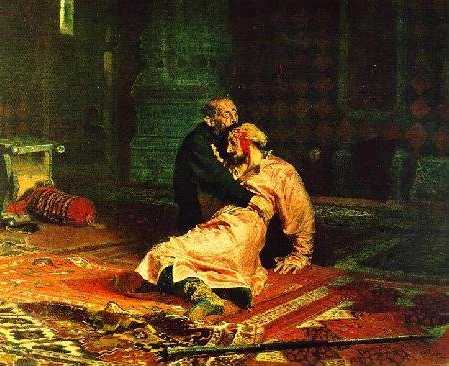Oil on canvas, 199.5 x 254 cm. Tretiakov Gallery, Moscow.
Oil on canvas, 199.5 x 254 cm. Tretiakov Gallery, Moscow.
 This famous work of Repin, Ivan the Terrible and
His Son Ivan: November 16, 1581, was painted in 1885. Repin started thinking
about the painting as early as in 1881, the year of the bloody assassination
of Alexander II, when, after a concert of Rimskii-Korsakov's Sweetness
of Revenge, he began to recall various other bloody episodes from Russian
history. Ivan the Terrible's murder of his own son seemed to be the most fitting
pretext to express the artist's rejection of all violence and bloodshed. The
work on the painting commenced after Repin finished They Did Not Expect
Him. As a model for the tsar Repin used his friend, the artist G.G.
Miasoedov, and for his son, the writer Vsevolod Garshin. The completed
painting, shown at the Thirteenth Exhibition of the Society of the Traveling
Exhibitions, was praised by the progressives and criticized by the conservatives.
Ivan Kramskoi, Repin's teacher, described the painting in an emotional
statement:
This famous work of Repin, Ivan the Terrible and
His Son Ivan: November 16, 1581, was painted in 1885. Repin started thinking
about the painting as early as in 1881, the year of the bloody assassination
of Alexander II, when, after a concert of Rimskii-Korsakov's Sweetness
of Revenge, he began to recall various other bloody episodes from Russian
history. Ivan the Terrible's murder of his own son seemed to be the most fitting
pretext to express the artist's rejection of all violence and bloodshed. The
work on the painting commenced after Repin finished They Did Not Expect
Him. As a model for the tsar Repin used his friend, the artist G.G.
Miasoedov, and for his son, the writer Vsevolod Garshin. The completed
painting, shown at the Thirteenth Exhibition of the Society of the Traveling
Exhibitions, was praised by the progressives and criticized by the conservatives.
Ivan Kramskoi, Repin's teacher, described the painting in an emotional
statement:
"What is expressed and emphatically accentuated is the incidental character of the murder! This most phenomenal aspect, an extremely difficult one to project, is achieved by means of only two figures. The father has struck his own son in the temple with the staff! A moment, and the father cries out in horror, dashes to the son and has seized him! Squatting on the floor, he raises him upon his knees, and firmly, firmly presses with one hand the wound on the temple (but blood flows in a gush between the finger slits), and with the other hand across the waist, presses him to his breast, and firmly, firmly kisses the head of this poor son (unusually appealing), and he roars (positively roars) from horror, in the helplessness of his condition. While throwing himself upon the son, tearing at his own head, the father stains the upper half of his face with blood -- a touch of Shakespearean tragicomedy. This animal shouts from horror -- and the sweet, precious son, resignedly dying, with his beautiful eyes and remarkably attractive mouth, his heavy breathing, his helpless hands. Oh, my God, could one quickly, quickly help! Who cares that on the painting there is already a whole puddle of blood in that place where the son's temple has hit the floor; who cares that there will yet be a full basin of blood -- the usual thing! A person mortally wounded will certainly lose a great deal of blood.
But how it is painted, God, how it is painted! Indeed, can you imagine a pool of blood not being noticed, not affecting you because of the frightful, highly expressive grief of the father, and his loud shriek? And in his hands his son, his son whom he has murdered. And the son cannot any longer control the pupil of his eye; he breathes heavily, feeling the grief of his father, his horror, his shriek, and he, like a baby, wishes to smile at him as if to say: "It's nothing, father, do not be afraid". . . ." (After Parker, 84). [A.B.]
